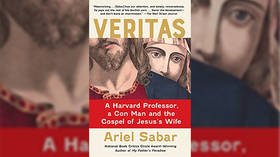Forged gospels: No historical figure has been as manipulated, distorted, and used for nefarious ends as egregiously as Jesus

Ariel Sabar masterfully dissects the dishonesty and narcissism inherent in nearly all Christian theological work in his book ‘Veritas: A Harvard Professor, a Con Man and the Gospel of Jesus’s Wife’.
Jesus Christ has been trotted out over the past two millennia to justify a litany of evils, including the Crusades, the Inquisition, the European conquest and genocide of the native peoples of the Americas, Puritan witch trials and the burning of heretics, slavery, the subjugation of women, the persecution of homosexuals, and, in the latest iteration, the endless wars in the Middle East.
Since there is so little known historically about Jesus, he is infinitely malleable. Every generation, and every brand of Christianity, has, for this reason, produced a Jesus in its own image. When I was a student at Harvard Divinity School, we read the German theologian Rudolf Bultmann, who, heavily influenced by Martin Heidegger, was an existentialist – and who, of course, turned Jesus into an existentialist.
The liberal church is as infected with this disease as right-wing Christians who have twisted Jesus into a Rambo-like white, male messiah for American capitalism, American imperialism, white supremacy, and patriarchy. And it is this dishonesty and narcissism, inherent in nearly all Christian theological work, that Ariel Sabar masterfully dissects in his book ‘Veritas: A Harvard Professor, a Con Man and the Gospel of Jesus’s Wife’.
Also on rt.com ‘God Bless Abortions’ sign draped across massive Jesus statue in Arkansas by activists over ‘attempts to ban’ terminationsKaren King, a professor at Harvard Divinity School, made a startling announcement in September 2012 at a conference in Rome. She had obtained, she told the gathering, a second-century papyrus fragment with a text suggesting that Jesus was married to Mary Magdalene and that she was considered one of the disciples. King called the fragment, the size of a business card, ‘The Gospel of Jesus’s Wife’ – a clever marketing ploy, especially since it was impossible to know where the text, which turned out to be a crude forgery, came from. Even if it was real, it could have been nothing more than a tiny scrap of paper rolled up and worn in an amulet. But King, if nothing else, was media savvy, and ‘The Gospel of Jesus’s Wife’ catapulted her ‘discovery’ to international fame.
She had already gotten a taste of popular acclaim, hitching herself to Dan Brown’s 2003 novel ‘The Da Vinci Code’, which was to Biblical scholarship what ‘Raiders of the Lost Ark’ was to archeology. In the novel, Brown makes Mary Magdalene the wife of Jesus, pregnant with Christ’s child when he was crucified. ‘The Da Vinci Code’ was only a few degrees separated from the claims made by scholars like King, who published her book, ‘The Gospel of Mary Magdala: Jesus and the First Woman Apostle’, the same year as Brown’s novel. She instantly became a ubiquitous media presence, defending the novel despite its numerous Biblical and historical inaccuracies. “She appeared in cover stories about the book in Time, Newsweek and U.S. News & World Report and became a regular on Code-themed TV specials, on ABC’s Primetime, NBC’s Dateline and CNN Presents,” Sabar writes in ‘Veritas’. In some of these media appearances she was joined by Brown. On the movie version of Brown’s novel, starring Tom Hanks, King is listed as a ‘consultant’. The novel transformed King from “a scholar whose intellectual passions had been confined to classrooms, academic tracts and the occasional church into a best-selling author with live audiences of hundreds and a television viewership of millions.” ‘The Gospel of Jesus’s Wife’ returned her to the epicenter of popular culture and the mass media.
King has spent her career championing the idea that Mary Magdalene and women in the early church played a prominent role in Jesus’ ministry. She is a scholar of Gnostic texts, texts from the second to fourth centuries that did not make it into the church-approved canon. The Gnostics were condemned as heretics by the early church and their writings were banned. The Gnostics believed that an elect group of believers, themselves, had been given a secret knowledge – the Greek word ‘gnosis’ means knowledge of spiritual mysteries – about the divine status of human beings that was obscured by the Old Testament and revealed to them by Jesus, who was regarded as an illuminator rather than the resurrected savior.
Also on rt.com Priest gagged for saying Canada residential-school victims lied about abuse for ‘extra money’ & joke about SHOOTING church vandalsThe Gnostics were, as Sabar writes, “socially estranged, more open to women, less violent, more centered on the self,” a belief system that catered to the inwardly focused zeitgeist of America’s consumer society. It appears from the fragments of the Gnostic texts that the sect included female leadership, something King explored, although often through very liberal interpretation, in ‘The Gospel of Mary Magdala: Jesus and the First Woman Apostle’.
King, as Sabar writes, “placed a heavy burden on the Gospel of Mary.” It didn’t matter that more than half of its pages were missing, obscuring its ultimate meanings. It didn’t matter that most scholars saw it as too late to compete with the canon. King, who titled her book ‘The Gospel of Mary Magdala’, even though the gospel nowhere identifies its ‘Mary’ as Magdalene, wanted the text to say things – and be things – that the available facts didn’t always support. In many fields, an incomplete one-of-a-kind data point might deter a scholar from making sweeping generalizations. But King went in precisely the opposite direction. She not only built ‘the history of Christianity’ atop the discontinuous surviving nine pages of a single text; she called its portrait of the faith’s first centuries “in a number of respects more historically accurate than that of the master story.”
From the beginning, King obscured the origins of the fragment. She refused to disclose the identity of the donor. She did not show the scholars at the conference in Rome photographs of the text, as is customary in academic conferences. She worked with the Smithsonian Channel to produce a documentary before the papyrus was analyzed and vetted. She eventually turned to close friends, who lacked expertise, to test the papyrus and authenticate the text. She openly dismissed the need for scientific testing, telling Sabar that chemical tests were “not usually done and not relevant.” Carbon dating, she said, “was too imprecise,” and multispectral analysis – the imaging technique that can help identify erased or overwritten text – “wasn’t going to show anything.”
Her disdain for science and fact is rivaled only by the Christian right, which has also fallen prey to forgers. The billionaire evangelical owners of the Hobby Lobby, for example, have spent millions buying up Biblical artifacts to prove “the absolute authority and reliability of the Bible.” It is the flip side of King’s interpretation of the Bible. They were duped into buying fake Dead Sea Scroll fragments and a forged text, supposedly from Leviticus, condemning homosexuality.
Also on rt.com Pope Francis discharged from Rome hospital 10 days after intestinal surgeryWhen King’s claims were peer reviewed by two expert Coptic papyrologists in the Harvard Theological Review, they warned that the fragment was probably a fake. King used her clout with the publication to publish her findings without their critiques, leaning instead on one positive review by a friend who did not specialize in early Coptic Christian literature. Harvard University and the Harvard Theological Review, it turned out, were not immune to the media frenzy and the obfuscations needed to perpetuate it.
Sabar’s dogged reporting uncovered not only King’s numerous schemes to pass the forgery off as real, but the identity of the forger, a German expatriate living in Florida named Walter Fritz who had a fake Egyptology degree, was a former director of the Stasi Museum in East Germany, and produced online pornographic videos of his wife having sex with multiple other men. The tissue of lies and deceit, from the hands of the forger up the chain to King and Harvard Divinity School, is staggering.
Perhaps most disturbing is King’s apparent indifference to the truth, even once the text was unmasked as a forgery. She told Sabar she was “not particularly” interested in what he had uncovered, and said she did not realize that an object’s past could be studied.
“How could a historian, one at Harvard no less, have failed to see provenance as a subject to investigation?” Sabar asks. “Provenance, after all, was nothing more than history – King’s own scholarly discipline.”
King, like many academics, is infected with the disease of postmodernism. To them, there is no discernable, objective truth. Truth is a language game. It is determined by those who tell the best story. History is, they argue, a form of fiction. Facts, along with linear time, do not matter as long as the story told feels true and relevant.
History, King writes, “is not about truth but about power relations.” She argues that historians must abandon “the association between truth and chronology.” She calls for “reconceptualizing the Western construction of time” and sees history as “discontinuous and unpatterned.” History, she writes, “is not serious, real or true.” History, she insists, is about “enlarging one’s imaginative universe” and never saying “no to a story, a song, a poem that gives life, heartens, teaches, or consoles, and need never fail to call it true.” She calls facts “little tyrannies.” Those bound by facts, she writes, are constricted by “fact fundamentalism.” She even concedes that Jesus’s marital status is finally unknowable, but also says this is irrelevant. As Sabar points out about King and the postmodernists, “a thing is true not if it is real; it is true if – in King’s estimation – it was a moral good.”
“In this view, every historical account – every piece of writing, for that matter – was a kind of stealthy sales pitch, a self-serving tale that promoted the interests of a particular individual or group,” Sabar writes. “The same held for reading. Whether Mary Magdalene was a prostitute or an apostle, for instance, turned less on ‘what happened’ than on which camp – pro-sinner or pro-saint – best publicized its interpretation.”
Also on rt.com By suggesting all Christians are Republican, Biden’s IRS is making America more polarized than everSabar hits on something very important: the corruption and dishonesty of postmodern scholarship, the deforming of fact and history to serve ideologies and beliefs. King is a product of a collective of liberal, postmodern theologians known as the Jesus Seminar, which routinely sacrificed serious scholarship to advance a liberal interpretation of the Christian gospels, making them no different from the owners of the Hobby Lobby. The group dismisses most of the sayings of Jesus in the Gospels as invented, writes off the entire Gospel of John as fiction, and does not believe in miracles or the resurrection. But to advance the cause of feminism, it twisted itself into contortions to assert that the scene at the end of the Gospel of John, where Mary witnesses the resurrected Jesus, is a real-life version of an actual historical event.
“A group that set out to tell the public what Jesus really said and did had decided that a vision in a book it called false could be the basis for the reality of Magdalene’s witness to a resurrection that never happened,” Sabar writes.
A society that severs itself from discourse rooted in verifiable fact commits moral and intellectual suicide. Facts become indistinguishable from opinions. This war on truth, on science, and on fact, whether from the liberal postmodern elites or the right-wing Christian fascists, widens the social divides. Believers on each side of the divide can no longer communicate. A culture that disdains truth and fact rapidly calcifies and dies. It bifurcates, as I saw in the former Yugoslavia, into antagonistic warring tribes.
This severance from reality fuels hate and finally violence. Competing demographics expend their energy demonizing the other. This is the most important lesson in Sabar’s meticulous study of the dishonesty and moral corruption that is eating away at the heart of America. That this story was set at Harvard Divinity School is not surprising to those of us who have watched the liberal church fold in on itself and orchestrate its own irrelevance. It would be comforting if King was an anomaly. Unfortunately, she is not.
This article was first published here at Scheerpost
The statements, views and opinions expressed in this column are solely those of the author and do not necessarily represent those of RT.














